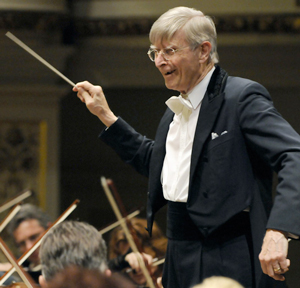by Daniel Hathaway
The Cleveland Orchestra never fails to play at a high level, producing results that can make even an indifferent guest conductor look good. When the orchestra collaborates with someone as inspiring as Herbert Blomstedt, the outcome can be sheer magic. The second weekend of Blomstedt’s sojourn at Severance Hall treated audiences to luminous and revealing performances of symphonies by Mozart and Dvorak so well-known and so often played that they can seem as ordinary as the furniture in your living room.
Cleveland Orchestra never fails to play at a high level, producing results that can make even an indifferent guest conductor look good. When the orchestra collaborates with someone as inspiring as Herbert Blomstedt, the outcome can be sheer magic. The second weekend of Blomstedt’s sojourn at Severance Hall treated audiences to luminous and revealing performances of symphonies by Mozart and Dvorak so well-known and so often played that they can seem as ordinary as the furniture in your living room.
For Mozart’s second g-minor symphony (No. 40), the 84-year old Swedish-American maestro scaled down the string section by one-half to two-thirds, discarded both baton and podium and led the ensemble from memory at stage level.
The increased ratio of winds to strings produced a colorful, robust sound. Blomstedt’s bare-handed approach to shaping the music through a variety of expressive gestures gave phrases an extraordinary suppleness. All the while, the underlying rhythm was as steady but subliminal as the ticking of an atomic clock. Blomstedt set brisk tempos at the outset of each movement and every nuance — there were plenty of those — took place inside those reliable beats.
One impressive example of that rhythmic steadiness was the slow movement, which features a persistent, twitchy, short-long, short-long motive that begins on the beat. It’s easy to relax and let that figure migrate to just before the beat, where it sounds like a “grace” note instead of what Mozart intended — and lends a nervous edge to the music. Even through both repeated sections, that figure stayed put and pristine on Thursday evening, giving the movement unusual flow and direction.
Dvorak’s ninth symphony followed intermission. Blomstedt, now supplied with both podium and baton but carrying the score in his head, presided over a strong, clear-headed and healthy reincarnation of an old warhorse so fresh and vibrant that it earned its subtitle, From the New World.
It’s difficult to pin down exactly how Blomstedt pulls his interpretational miracles off, but it’s certain that he knows his scores on a deep level, keeps things moving, makes clean and instantaneous transitions between sections and — while uncovering a wealth of nuances — never ventures into the sentimental. The famous slow movement is a case in point. Robert Walters’s English horn solo — like the symphony’s many solo wind moments — was lovely but never became self-indulgent; it had its place in the architecture of the movement, but there were also other elements that deserved attention.
Blomstedt also trusts his orchestral colleagues (and vice versa); he guides them but gives them a long leash and the permission to play brilliantly after their own instincts. That mutual respect was very clear at the end of the Dvorak, when Blomstedt gave the splendid horns a bow, followed by the winds and every other section of the orchestra in turn. On his fourth return to the stage, he got a solo bow himself from the players, who clapped, stomped feet and refused to stand. That love feast was capped by the surprise of an encore: one of Dvorak’s giddily spirited Slavonic Dances played with the brilliance The Cleveland Orchestra has cultivated ever since George Szell. That was itself a tribute; in a video interview, Herbert Blomstedt remembered hearing them on the radio from Cleveland while growing up in Sweden.
Published on ClevelandClassical.com February 26, 2013
Click here for a printable version of this article.


